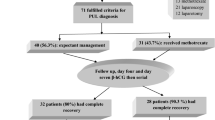Abstract
Objective
To observe efficacy following methotrexate (MTX) management in women with placenta accreta.
Methods
Twenty-four stable patients with placenta accreta were treated with MTX. Beta-hCG values, vascular indices of the residual placenta, and other clinical characteristics were collected prospectively and were compared between the success and failure groups.
Results
After MTX management, the residual placentas were expulsed spontaneously in 33.3 % of the patients. This was done through dilatation and curettage (D & C) in 45.8 % of the patients. The residuals in the uterine wall were completely absorbed within 5.7 months. In the patients who were successfully treated with MTX, their beta-hCG values and vascular indices of the placentas decreased faster than those of failure patients (P < 0.05). Those (20.8 %) failing MTX management and subsequent D & C showed that their vascular indices persisted high levels and some even experienced elevations despite significantly decreased hCG values.
Conclusions
MTX management, when the beta-hCG value and vascular indices of placenta decreased significantly, is a conservative option for a stable patient with placenta accreta in China. 3D power Doppler ultrasound should be utilized for the follow-up of this condition.

Similar content being viewed by others
References
Fox H (1972) Placenta accreta, 1945–1969. Obstet Gynecol Survey 27:475–490
Pinho S, Sarzedas S, Pedroso S et al (2008) Partial placenta increta and methotrexate therapy: three case reports. Clin Exp Obstet Gynecol 35:221–224
Crespo R, Lapresta M, Madani B (2005) Conservative treatment of placenta increta with methotrexate. Int J Gynaecol Obstet 91:162–163
Winick M, Coscia A, Noble A (1967) Cellular growth in human placenta I. Normal placental growth. Pediatrics 39:248–251
Legro RS, Price FV, Hill LM et al (1994) Nonsurgical management of placenta percreta: a case report. Obstet Gynecol 83:847–849
Gielchinsky Y, Rojansky N, Fasouliotis SJ et al (2002) Placenta accreta—summary of 10 years: a survey of 310 cases. Placenta 23:210–214
Palacios-Jaraquemada JM (2008) Diagnosis and management of placenta accreta. Best Pract Res Clin Obstet Gynaecol 22:1133–1148
Pairleitner H, Steiner H, Hasenoehrl G et al (1999) Three-dimensional power Doppler sonography: imaging and quantifying blood flow and vascularization. Ultrasound Obstet Gynecol 14:139–143
Hoveyda F, MacKenzie IZ (2001) Secondary postpartum haemorrhage: incidence, morbidity and current management. Br J Obstet Gynaecol 108:927–930
Placenta accreta (2002) ACOG Committee Opinion. No. 266. American College of Obstetricians and Gynecologists. Obstet Gynecol 99:169–170
Timmermans S, van Hof AC, Duvekot JJ (2007) Conservative management of abnormally invasive placentation. Obstet Gynecol Sur 62(8):529–539
Arulkumaran S, Ng CS, Ingemarsson I et al (1986) Medical treatment of placenta accreta with methotrexate. Acta Obstet Gynecol Scand 65:285–286
Flam F, Karlstrom PO, Carlsson B et al (1999) Methotrexate treatment for retained placental tissue. Eur J Obstet Gynecol Reprod Biol 83:127–129
de Paula CF, Ruano R, Campos JA et al (2009) Quantitative analysis of placental vasculature by three-dimensional power Doppler ultrasonography in normal pregnancies from 12 to 40 weeks of gestation. Placenta 30:142–148
Shih JC, Palacios Jaraquemada JM et al (2009) Role of three-dimensional power Doppler in the antenatal diagnosis of placenta accreta: comparison with gray-scale and color Doppler techniques. Ultrasound Obstet Gynecol 33:193–203
Kulkarni A, Draycott T (2005) The use of serial beta-HCG to plan surgical evacuation of retained placenta in a case of placenta accreta. J Matern Fetal Neonatal Med 17:295–297
Matsumura N, Inoue T, Fukuoka M et al (2000) Changes in the serum levels of human chorionic gonadotropin and the pulsatility index of uterine arteries during conservative management of retained adherent placenta. J Obstet Gynaecol Res 26:81–87
Lathrop E, Schreiber C (2012) Controversies in family planning: management of second-trimester pregnancy terminations complicated by placenta accreta. Contraception 85:5–8
Acknowledgments
We appreciate the financial support of the Nature Science Foundation of Zhejiang Province (Y2110128). We would like to acknowledge the members of Ultrasound Department and Obstetrics Department for making their data available.
Conflict of interests
The authors declare that there are no conflicts of interest. We appreciate the financial support of the Nature Science Foundation of Zhejiang Province (Y2110128). We state that we have had full control of all primary data and that we agree to allow the Journal to review our data if requested.
Author information
Authors and Affiliations
Corresponding author
Rights and permissions
About this article
Cite this article
Lin, K., Qin, J., Xu, K. et al. Methotrexate management for placenta accreta: a prospective study. Arch Gynecol Obstet 291, 1259–1264 (2015). https://doi.org/10.1007/s00404-014-3573-1
Received:
Accepted:
Published:
Issue Date:
DOI: https://doi.org/10.1007/s00404-014-3573-1




